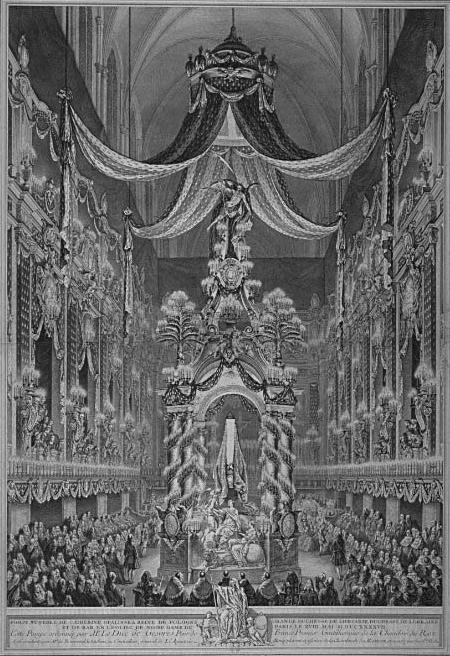Castrum Doloris on:
[Wikipedia]
[Google]
[Amazon]
 Castrum doloris (
Castrum doloris (
 Castrum doloris (
Castrum doloris (Latin
Latin (, or , ) is a classical language belonging to the Italic branch of the Indo-European languages. Latin was originally a dialect spoken in the lower Tiber area (then known as Latium) around present-day Rome, but through the power of the ...
for ''castle of grief'') is a name for the structure and decorations sheltering or accompanying the catafalque
A catafalque is a raised bier, box, or similar platform, often movable, that is used to support the casket, coffin, or body of a dead person during a Christian funeral or memorial service. Following a Roman Catholic Requiem Mass, a catafalque ...
or bier
A bier is a stand on which a corpse, coffin, or casket containing a corpse is placed to lie in state or to be carried to the grave.''The American Heritage Dictionary of the English Language'' (American Heritage Publishing Co., Inc., New York, ...
that signify the prestige or high estate of the deceased. A ''castrum doloris'' might feature an elaborate baldachin
A baldachin, or baldaquin (from it, baldacchino), is a canopy of state typically placed over an altar or throne. It had its beginnings as a cloth canopy, but in other cases it is a sturdy, permanent architectural feature, particularly over h ...
and would include candle
A candle is an ignitable wick embedded in wax, or another flammable solid substance such as tallow, that provides light, and in some cases, a fragrance. A candle can also provide heat or a method of keeping time.
A person who makes candles i ...
s, possibly flower
A flower, sometimes known as a bloom or blossom, is the reproductive structure found in flowering plants (plants of the division Angiospermae). The biological function of a flower is to facilitate reproduction, usually by providing a mechani ...
s, and in most cases coats of arms
A coat of arms is a heraldic visual design on an escutcheon (i.e., shield), surcoat, or tabard (the latter two being outer garments). The coat of arms on an escutcheon forms the central element of the full heraldic achievement, which in its wh ...
, epitaph
An epitaph (; ) is a short text honoring a deceased person. Strictly speaking, it refers to text that is inscribed on a tombstone or plaque, but it may also be used in a figurative sense. Some epitaphs are specified by the person themselves be ...
s and possibly allegorical
As a literary device or artistic form, an allegory is a narrative or visual representation in which a character, place, or event can be interpreted to represent a hidden meaning with moral or political significance. Authors have used allegory th ...
statue
A statue is a free-standing sculpture in which the realistic, full-length figures of persons or animals are carved or cast in a durable material such as wood, metal or stone. Typical statues are life-sized or close to life-size; a sculpture t ...
s. Many extensive ''castra doloris'' can be traced to the customs of 17th century and 18th century or even earlier, since the funeral arrangements of Sigismund II Augustus
Sigismund II Augustus ( pl, Zygmunt II August, lt, Žygimantas Augustas; 1 August 1520 – 7 July 1572) was King of Poland and Grand Duke of Lithuania, the son of Sigismund I the Old, whom Sigismund II succeeded in 1548. He was the first ruler ...
included a ''castrum doloris'' in 1570s.
See also
*Funeral Crown
The Funeral Crown ( pl, Korona Pogrzebowa), also known under its Latin name as the ''Corona Funebris'' or ''Funebralis'', was a part of the Polish Crown Jewels.
It was probably lost before 1669.
History
The crown was executed around 1586 for fun ...
* coffin portrait
A coffin portrait ( pl, Portret trumienny) was a realistic portrait of the deceased person put on coffins for the funeral and one of the elements of the castrum doloris, but removed before the burial. It became a tradition to decorate coffins of ...
s: Notable examples includes ( pl, portret trumienny) from the Polish–Lithuanian Commonwealth
The Polish–Lithuanian Commonwealth, formally known as the Kingdom of Poland and the Grand Duchy of Lithuania, and, after 1791, as the Commonwealth of Poland, was a bi-confederal state, sometimes called a federation, of Crown of the Kingdom of ...
.
Visual arts genres
Death customs
Latin words and phrases
{{Death-stub